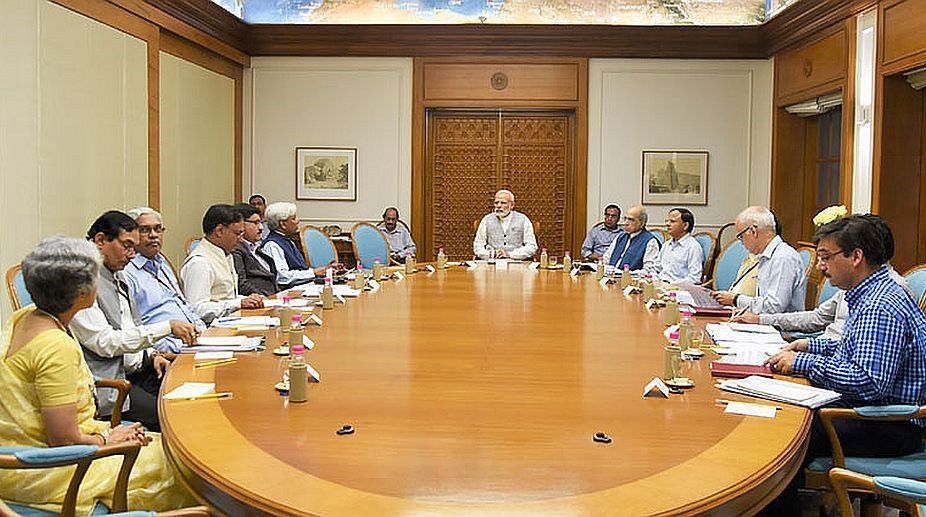
Indian Prime Minister Narendra Modi’s new council of ministers unveiled yesterday clearly indicates that he has opted to retain his authority over policy formulation and continuity to be the main determinants for choosing his team to run the country for a third successive term.
The third term of the Modi-led NDA government has a maximum of 31 cabinet ministers, including Modi, five ministers of state (with Independent Charge) and 36 ministers of state.
Modi has retained most of the senior BJP leaders of his previous dispensation and, at the same time, inducted some new faces.
The cabinet has several heavyweight leaders of the BJP, including six former chief ministers and ministers, who have been retained this time for their good performance in Modi’s previous dispensation.
Among the 30 cabinet ministers are BJP seniors like Rajnath Singh, Amit Shah, Nitin Gadkari, party president J P Nadda, former Madhya Pradesh Chief Minister Shivraj Singh Chouhan, Nirmala Sitharaman, S Jaishankar, Manohar Lal (Khattar), Piyush Goyal, Dharmendra Pradhan, Sarbananda Sonowal, Pralhad Joshi, Jual Oram, Giriraj Singh, Ashwini Vaishnaw, Jyotiraditya Scindia, Bhupender Yadav, Gajendra Singh Shekhawat, Annpurna Devi, Kiren Rijiju, Hardeep Singh Puri, Mansukh Mandaviya and G Kishan Reddy.
Several of these ministers were part of the ministerial council in Modi’s first two terms as well.
At least 18 senior ministers will be heading ministries, indicating that Modi has blended continuity and change to pick his new council of ministers.
The new ministry includes 43 ministers who have served three terms or more with 39 having been ministers at the Centre before.
The composition reflects Modi intends to hit the ground running as per his first 100-day plan of action for his next government. This is a plan he had talked about in public even before the parliamentary election schedule was announced and repeated thereafter.
Given BJP’s critical dependence on its allies this time in the absence of a majority on its own in the 543-member Lok Sabha where halfway mark is 272, the party’s NDA partners got 11 ministerial berths—five cabinet and six ministers of state in the third term of Modi, as against just two junior ministers in the previous dispensation.
This time, there are two ministers of state with independent charge and four ministers of state.
BJP allies H D Kumaraswamy of Janata Dal (Secular), Jitan Ram Manjhi of Hindustani Awam Morcha, Rajiv Ranjan alias Lalan Singh of Janata Dal (United), Kinjarapu Ram Mohan Naidu of Telugu Desam Party and Chirag Paswan of Lok Janshakti Party took oath as cabinet ministers on Sunday at a ceremony at the Rashtrapati Bhavan.
These ministers are from Karnataka, Andhra Pradesh and Bihar. However, the allies have been given only one cabinet berth each.
Some smaller NDA partners like Nationalist Congress Party and Shiv Sena (Shinde faction) have no representation in the new cabinet.
Jayant Chaudhary of Rashtriya Lok Dal and Prataprao Jadhav of Shiv Sena (Shinde) were inducted as ministers of state with independent charge while Anupriya Patel of Apna Dal was made a minister of state.
The profile of the presence of NDA allies is a strong indicator of the fact that Modi is seeking to keep the reins with himself as far as important policy matters and governance decisions are concerned.
The BJP’s performance in the general election was below its expectations. Its tally of seats is reduced from 302 in 2019 to 240 in the present one. As many as 19 ministers were among those who lost the recent Lok Sabha poll and most have been dropped from the new ministry.
But the exceptions are L Murugan who has been retained as a minister in view of Modi’s efforts to expand BJP’s footprints in the southern state of Tamil Nadu where the party failed to win a single seat despite a high-pitched campaign.
Ravneet Singh (Bittu) from Punjab who switched from Congress to BJP and lost the Lok Sabha election this time, has been made a junior minister. In Punjab politics too, the BJP is a negligible player.
As far as the caste composition of Modi’s new council of ministers is concerned, 27 of the ministers belong to the backward castes, 10 are from Scheduled Castes and five each from the Scheduled Tribes and minority communities.
BJP, however, bypassed its core voter base of Vaishyas (Baniyas) but took care to include a minister from the Mallah community which is categorised as an Extremely Backward Class.
Rajputs and Kayasthas have also not found a place in the new council of ministers unlike in 2019 when R K Singh, Rajiv Pratap Rudy and Radha Mohan Singh (all Rajputs) and Ravi Shankar Prasad (Kayastha) were inducted.
____________________________
The writer is a veteran Indian journalist

